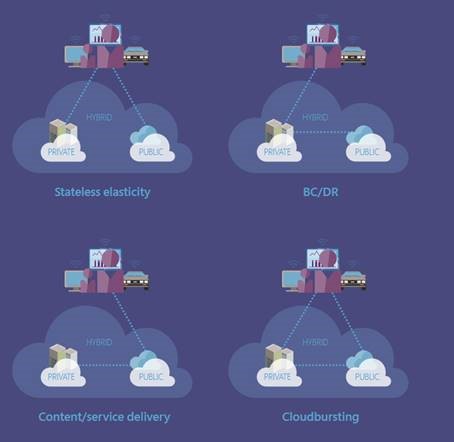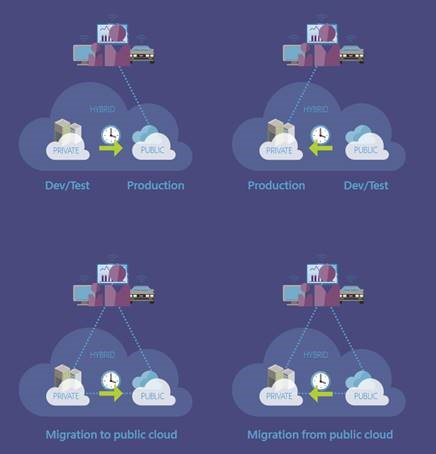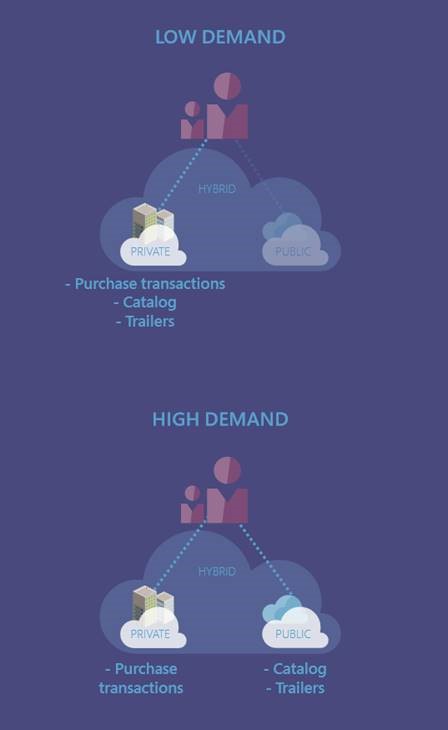Hybrid Cloud: The Best of Both Worlds - Hybrids in Space and Time
This blog post is authored by Joe Weinman , author of Cloudonomics: The Business Value of Cloud Computing, and the forthcoming book Digital Disciplines, which explores four business strategies to exploit emerging digital technologies such as cloud computing.
This is the third installment in our blog series “Hybrid Cloud: The Best of Both Worlds.” If you missed our first two posts: An Introduction to the Benefits of Hybrid Cloud and The Rationale for Hybrids, we invite you to read them. Today we want to introduce you to the different scenarios and architectures in which hybrid solutions can be deployed.
Hybrids in Space
A hybrid cloud computing environment typically includes users and/or connected things, private cloud resources, and one or more public cloud services. There are multiple possible such configurations.
In the case of stateless elasticity, such as serving static web pages, load balancers can route users to private or public resources.
In another case, the cloud acts as the front end, and the enterprise data center is the back end. For example, the cloud may offer content delivery, say, for a web-based catalog, while financial transactions are executed at the enterprise data center when a customer orders.
In the reverse, the enterprise is the front-end while the public cloud is the back end. For example, commercial orders and transactions of record may both occur within the private cloud, and snapshots of the general ledger database, say, may be kept in the public cloud.
In an increasingly viable scenario—often referred to as “cloudbursting”—the same application architecture is run in both private and public clouds, and public cloud resources are increasingly brought to bear as demand exceeds the capacity of the dedicated enterprise resources.
Hybrids in Time
Although less traditionally viewed as a hybrid, we can also think of four generic hybrids in time.
In one, development and/or testing is run in the public cloud and when it is time for production, the application is run in the enterprise.
In the reverse scenario, dev/test is run in the private cloud, or even a desktop or workstation, and then the application is moved to the public cloud for production.
In another scenario, everything—development, test, and production—is run in the private cloud, but at some point, due to strategy or economics, it is migrated to the public cloud.
In the reverse scenario, a company, perhaps a startup, bases its IT initially on a public cloud strategy, and once it reaches a level of stability in both architecture and demand, migrates its applications to its own data center.
Such choices are sometimes based on economics: a social gaming company found a three-fold improvement by migrating from public to private, and a cross-platform application found a four-fold gain. Some applications are less expensive to run in the public cloud, or reduce risk through elasticity. It can also be a strategic choice: a large global streaming media company plans to close all of its own data centers to focus on its core business of creating, transcoding, delivering, and recommending content.
Complex Hybrids
Mixes of all of these scenarios and economic and behavioral drivers can and do occur based on the requirements of the business. For example, a global entertainment company found that its web site, hosted entirely on internal resources, went down during the death of one of its most popular stars, as a global public eagerly sought information about the artist. It re-architected its application and deployment strategy so that during periods of normal load, all traffic is sent to the corporate data center. However, if demand for artist info and memorabilia spikes beyond the data center’s capacity, it would be increasingly handled by a public cloud while the purchase transactions would still be handled by the company directly.
In yet another approach, which today is extremely prevalent, multiple public cloud providers complement applications or components in the enterprise data center, e.g., one SaaS provider for CRM, another for document sharing and yet another for object storage, say, backing up data from the first two providers. Over time, greater levels of application and data integration between these various components or microservices such as credit card validation will occur.
Stay tuned for our next blog post in this series The Hybrid Essentials (coming February 20).
For a sneak peak into our final installment, you can read the entire “Hybrid Cloud: The Best of Both Worlds” by Joe Weinman here.
For more thoughts and insights on hybrid cloud, we invite you to join us for the “Hybrid Cloud: The Best of Both Worlds” webinar hosted by Joe Weinman on 2/24. You can register for the webinar here.


